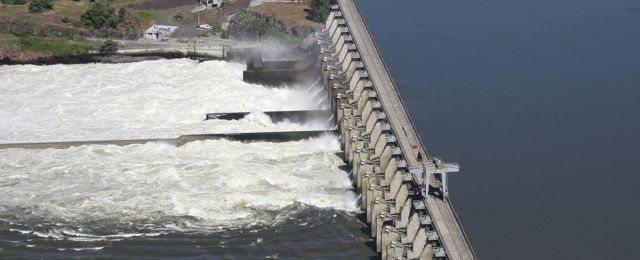forum
library
tutorial
contact

Fish or Dams?
Why Not Try a Third Choice?
by Marty Trillhaase
Lewiston Tribune, May 6, 2012
|
the film forum library tutorial contact |

|
Fish or Dams?
by Marty Trillhaase
|
 U.S. District Judge James Redden caused a lot of sparks when he endorsed breaching the four lower Snake River dams in order to preserve salmon and steelhead runs.
U.S. District Judge James Redden caused a lot of sparks when he endorsed breaching the four lower Snake River dams in order to preserve salmon and steelhead runs.
Until he handed the case file over to U.S. District Judge Michael Simon last year, Redden had presided over the fish-vs.dams lawsuits, striking down three federal government fish recovery plans - in 2000, 2004 and 2008 - as inadequate to protect fish under the Endangered Species Act.
So no one may be better informed about the law and the science behind the dispute. But it's only the opinion of one person - and an observer at that.
Look for Redden's legacy, not in an interview he gave Idaho Public Television's Aaron Kunz on April 14, but in a report fish scientists released two days earlier in Portland, Ore.
Six years ago, Redden ordered the Army Corps of Engineers and Bonneville Power Administration to open the spillways, enabling fish to better migrate to the sea. Six years later, the data is in - and the Comparative Survival Study annual conference at Portland suggests spill offers the Pacific Northwest its best opportunity to escape the stark choice between losing its fish or closing its dams.
After more than $10 billion invested in hatcheries, improving habitat, restricting harvests and adjusting hydro operations, the region is getting modest results. Three years ago, Idaho saw 13,670 wild spring-summer chinook and another 42,530 hatchery fish return to the Snake, Salmon and Clearwater rivers. That's better than the mid-1990s, when the numbers plummeted to as low 1,186 wild and 652 hatchery fish. But it's well short of sustainable levels, which the Northwest Power Conservation Council puts at between two and four adult fish returning for every 100 smolts that leave. Right now, the smolt-to-adult ratio is about 1 percent.
Controlling what happens to salmon in the ocean is virtually impossible.
But the river is a different matter. Even if fish survive passing through turbines, the trauma leaves them susceptible to disease or predators. Barging fish around dams also leaves the creatures less able to fight off infection or evade predators.
Spill, however, began yielding results from the time Redden imposed his order. Fish entered the ocean less stressed and in better health. So more of them returned three years later.
About 40 percent of the river flows through the dam spillways during the April through August migration season. Increase that to between 55 percent and 60 percent - or just short of the point at which nitrogen levels in the water become unhealthy for fish - and you might experience long-term survival rates approaching 2 to 4 percent.
"It may get us into the ballpark," Fish and Game biologist Charles Petrosky told the Idaho Statesman's Rocky Barker. "I don't think it changes the past (conclusions), but it gives us something in between that has a lot of promise, and we ought to explore it."
A panacea? No. The more water that passes through a spillway, the less is used to generate hydropower.
But it's one approach that could boost fish numbers without undermining north central Idaho's and eastern Washington's river navigation system.
It's also within the realm of the possible. Breaching requires an act of Congress. Spill needs only a court order. But that only contributes to more endless litigation.
To give accelerated spill a genuine chance at success, you need commitment from all the parties involved. Only a political deal worked out at a conference table can deliver such an accord.
Which brings us to U.S. Sen. Mike Crapo, R-Idaho. Three years ago, Crapo proposed a collaborative approach. Bring together a regional conference of the states, Indian tribes, environmental groups and federal dam operators, he said. Leave nothing off the table, including breaching.
Is the CSS study the kind of breakthrough event that could lead to a political accommodation between fish advocates and dam operators? Without testing this hypothesis, nobody can be sure.
What it gives the region, however, is an intriguing new option to break a deadlock it has labored under for decades. Should something come of it, much of the credit will go to Redden.
learn more on topics covered in the film
see the video
read the script
learn the songs
discussion forum
